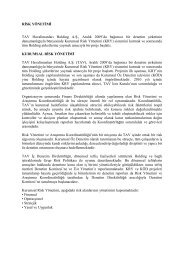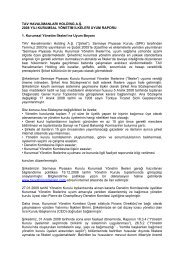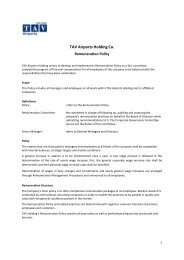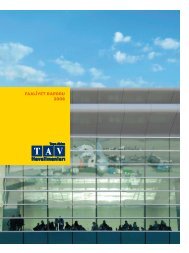TAV IT
TAV IT
TAV IT
You also want an ePaper? Increase the reach of your titles
YUMPU automatically turns print PDFs into web optimized ePapers that Google loves.
sustaınabılıty and the envıronment<br />
Airport Operation and its Environmental Impact<br />
Operations carried out at the airports inevitably closely impact<br />
the environment where they are located. The environmental<br />
problems arise particularly as a result of the expansion of<br />
airports that are located outside of cities, as well as the<br />
expansion of the cities they serve. As a result of the airports<br />
being located near the cities, they become integrated with the<br />
cities’ own environmental problems and create environmental<br />
impacts.<br />
Operational activities carried out at the airports that have<br />
environmental impacts are listed below:<br />
• Landing, takeoff and maneuvering of aircraft;<br />
• Operation of all motor vehicles and construction equipment<br />
serving the airports;<br />
• Chemicals used for clearing the aircraft and runways of snow<br />
and ice;<br />
• Storage needs and leakage risk of fuel, oils and similar<br />
chemicals used in aircraft;<br />
• Construction work performed for the maintenance, repair,<br />
modification and expansion of airport terminals, runways, aprons<br />
and taxi routes;<br />
• Chemicals and work needed for the maintenance, repair and<br />
cleaning of the terminals, operation buildings, vehicles and<br />
construction equipment, airplanes and other aircraft.<br />
The headings listed above have environmental impacts not just<br />
because of the emissions of chemicals, gases such as smoke<br />
and steam, liquids and solid wastes; but also because of noise,<br />
light, population density, and even the change in topographical<br />
structure.<br />
It is undoubtedly true that an airport forever changes the<br />
environment where it is built. Wildlife, vegetation cover and the<br />
like will never be as they were before.<br />
However, this change need not be harmful, destroy the<br />
environment or negatively impact nature, as it is usually<br />
perceived. Many more environmental projects have been<br />
undertaken in the last ten years of the 20th century and the first<br />
nine years of the 21st century. Airplanes emit nearly a quarter<br />
less of the noise now than previously, and according to some<br />
sources, exhaust gas emissions have been reduced by almost<br />
45%. Aircraft and aircraft engine manufacturers conscientiously<br />
fulfill their duties.<br />
Airports now act very conscientiously to minimize environmental<br />
impact and even expend efforts to make contributions. To offer<br />
a few examples, the factors taken into serious consideration by<br />
airport operators include measures such as renewable energy<br />
systems, utilization of environmentally friendly maintenance,<br />
repair and cleaning materials, acceleration of replacing ground<br />
service vehicles powered by diesel or gasoline fired internal<br />
combustion engines with electric vehicles, utilization of terminal<br />
and service building designs that do not significantly impact<br />
the topographical structure and that take into consideration the<br />
natural wind flows and surface structure, and heavier utilization<br />
of plants that are important for wildlife in landscaping.<br />
Without contenting themselves with only these measures,<br />
airport operators force aircraft and engine manufacturers to<br />
develop more environmentally friendly airplanes, helicopters and<br />
similar aircraft. For example, while the noise level of a typical<br />
jet engine during takeoff was around 170 to 185 Decibels in the<br />
1970s, today some airports fine individuals or companies whose<br />
airplanes exceed the noise level of 90 Decibels during takeoff.<br />
Furthermore, as emission (exhaust and similar gases) standards<br />
become more strict, airplanes that leave behind a black cloud of<br />
smoke can only be found in museums or salvage yards.<br />
While liquid and solid waste materials were negligently dumped<br />
into the nearest stream or shore before, now great efforts are<br />
undertaken for the recycling of these wastes and the laws and<br />
regulations on this issue are getting stricter by the day. Solutions<br />
are designed for the recycling and re-usage of the water used,<br />
and these solutions are turned into concrete projects, especially<br />
in Middle Eastern countries.<br />
The environmental matters discussed here are taken into<br />
consideration by all people and companies active in the aviation<br />
and airport operation sector. The environment also tops the<br />
agenda of authorities such as IATA and ACI.<br />
<strong>TAV</strong> Airports displays a particular sensitivity to the environment.<br />
As part of the “Trigeneration Project” implemented at the<br />
İstanbul Atatürk Airport, the Company is increasing its<br />
contribution to the environment through facilities that are<br />
self-sufficient in energy and air conditioning needs. This project<br />
reduces carbon dioxide emissions by 40% because of the use of<br />
natural gas in electricity generation, compared to fossil fuel-fired<br />
electricity generation plants, <strong>TAV</strong> Airports is also studying the<br />
feasibility of solar energy. The Company’s airports and terminals<br />
in Tunisia, Antalya Gazipaşa and İzmir that can most benefit

















